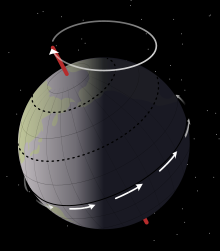
Back Aksiale presessie Afrikaans مبادرة محورية Arabic محورلیک سالینما AZB Апярэджванне раўнадзенстваў Byelorussian অক্ষীয় অয়নচলন Bengali/Bangla Precessió dels equinoccis Catalan Precese zemské osy Czech Zyklus der Präzession German Μετάπτωση των ισημεριών Greek Precesión de los equinoccios Spanish

In astronomy, axial precession is a gravity-induced, slow, and continuous change in the orientation of an astronomical body's rotational axis. In the absence of precession, the astronomical body's orbit would show axial parallelism.[2] In particular, axial precession can refer to the gradual shift in the orientation of Earth's axis of rotation in a cycle of approximately 26,000 years.[1] This is similar to the precession of a spinning top, with the axis tracing out a pair of cones joined at their apices. The term "precession" typically refers only to this largest part of the motion; other changes in the alignment of Earth's axis—nutation and polar motion—are much smaller in magnitude.
Earth's precession was historically called the precession of the equinoxes, because the equinoxes moved westward along the ecliptic relative to the fixed stars, opposite to the yearly motion of the Sun along the ecliptic. Historically,[3] the discovery of the precession of the equinoxes is usually attributed in the West to the 2nd-century-BC astronomer Hipparchus. With improvements in the ability to calculate the gravitational force between planets during the first half of the nineteenth century, it was recognized that the ecliptic itself moved slightly, which was named planetary precession, as early as 1863, while the dominant component was named lunisolar precession.[4] Their combination was named general precession, instead of precession of the equinoxes.
Lunisolar precession is caused by the gravitational forces of the Moon and Sun on Earth's equatorial bulge, causing Earth's axis to move with respect to inertial space. Planetary precession (an advance) is due to the small angle between the gravitational force of the other planets on Earth and its orbital plane (the ecliptic), causing the plane of the ecliptic to shift slightly relative to inertial space. Lunisolar precession is about 500 times greater than planetary precession.[5] In addition to the Moon and Sun, the other planets also cause a small movement of Earth's axis in inertial space, making the contrast in the terms lunisolar versus planetary misleading, so in 2006 the International Astronomical Union recommended that the dominant component be renamed the precession of the equator, and the minor component be renamed precession of the ecliptic, but their combination is still named general precession.[6] Many references to the old terms exist in publications predating the change.
- ^ a b Hohenkerk, C.Y., Yallop, B.D., Smith, C.A., & Sinclair, A.T. "Celestial Reference Systems" in Seidelmann, P.K. (ed.) Explanatory Supplement to the Astronomical Almanac. Sausalito: University Science Books. p. 99.
- ^ Lerner, K. Lee; Lerner, Brenda Wilmoth (2003). World of earth science. Farmington Hills, MI: Thomson-Gale. p. 105 and 454. ISBN 0-7876-9332-4. OCLC 60695883.
During revolution about the Sun, the earth's polar axis exhibits parallelism to Polaris (also known as the North Star). Although observing parallelism, the orientation of Earth's polar axis exhibits precession – a circular wobbling exhibited by gyroscopes – that results in a 28,000-year-long precessional cycle. Currently, Earth's polar axis points roughly in the direction of Polaris (the North Star). As a result of precession, over the next 11,000 years, Earth's axis will precess or wobble so that it assumes an orientation toward the star Vega.
- ^ Astro 101 – Precession of the Equinox Archived 2 January 2009 at the Wayback Machine, Western Washington University Planetarium. Retrieved 30 December 2008
- ^ Robert Main, Practical and Spherical Astronomy (Cambridge: 1863) pp.203–4.
- ^ Cite error: The named reference
Williamswas invoked but never defined (see the help page). - ^ "IAU 2006 Resolution B1: Adoption of the P03 Precession Theory and Definition of the Ecliptic" (PDF). Archived from the original (PDF) on 21 October 2011. Retrieved 28 February 2009.